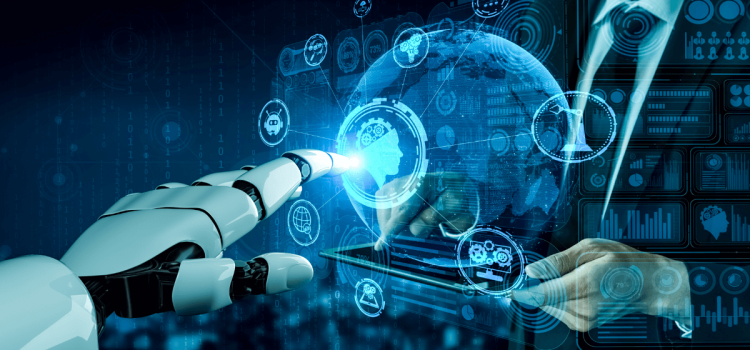
From Haves to Have-Nots: Unpacking AI’s Socio-Digital Threats
Introduction
AI is a powerful and transformative technology that can bring many benefits to society, such as enhancing productivity, improving health care, and advancing education. However, AI also poses many challenges and risks, such as creating or worsening inequality, injustice, and manipulation. These are the socio-digital threats of AI, and they are not inevitable. They are the result of human choices and actions, and they can be avoided or mitigated by making better choices and actions.
In this article, I will explain what the socio-digital threats of AI are, why they are dangerous, and how to avoid them. I will also provide some examples of how AI can be used for good, rather than evil. I hope that by reading this article, you will gain a deeper understanding of the ethical and social implications of AI, and how to use it responsibly and wisely.
What are the Socio-Digital Threats of AI?
The socio-digital threats of AI are the negative impacts that AI can have on society and individuals, especially on the vulnerable and marginalized groups. They are the result of AI being used to replace, exploit, or harm humans, rather than to augment, empower, or help them. They are also the result of AI being designed, developed, or deployed without considering the ethical, legal, or social implications, or without involving the stakeholders and users.
Some of the socio-digital threats of AI are:
- Lack of AI transparency and explainability: AI and deep learning models can be difficult to understand, even for experts, let alone for the general public. This can lead to a lack of trust, accountability, and responsibility for the decisions and actions made by AI systems, especially when they affect human lives, rights, or well-being.
- Job losses due to AI automation: AI-powered job automation is a pressing concern, as the technology is adopted in various sectors and industries. AI can replace human workers, especially those who perform routine, repetitive, or low-skill tasks, leading to unemployment, income loss, and social exclusion.
- Social manipulation through AI algorithms: AI can be used to manipulate human behavior, opinions, and emotions, through platforms such as social media, search engines, or recommender systems. AI can generate or amplify fake news, misinformation, propaganda, or hate speech, influencing the public discourse and undermining democracy.
- Discrimination and bias in AI systems: AI can reflect or amplify the existing biases and prejudices in society, such as racism, sexism, or classism, through the data, algorithms, or outcomes of AI systems. AI can discriminate against certain groups or individuals, affecting their access to opportunities, resources, or services, such as education, health care, or justice.
- Techno-solutionism and determinism in AI applications: AI can be seen as a panacea or a curse, rather than a tool, for solving societal problems. This can lead to an over-reliance or an under-appreciation of AI, ignoring the human, social, or environmental factors that are involved in the problem or the solution. AI can also be seen as inevitable or unstoppable, rather than contingent or controllable, limiting the human agency and choice in shaping the future of AI.
These are some of the socio-digital threats of AI, but they are not exhaustive. There may be other threats that are not yet identified or anticipated, or that may emerge in the future, as AI evolves and expands. Therefore, it is important to monitor and assess the impacts of AI on society and individuals, and to take preventive or corrective actions when needed.
Why are the Socio-Digital Threats of AI Dangerous?
The socio-digital threats of AI are dangerous because they can undermine the values and principles that are essential for a fair, just, and democratic society, such as human dignity, autonomy, equality, diversity, and solidarity. They can also erode the trust and confidence that are necessary for a healthy and productive relationship between humans and AI, such as transparency, accountability, responsibility, and cooperation. They can also create or worsen the gaps and conflicts that are detrimental for a peaceful and harmonious society, such as inequality, injustice, and violence.
The socio-digital threats of AI are dangerous not only for the present, but also for the future. They can have long-term and irreversible consequences for the human condition, such as the loss of identity, agency, or meaning. They can also have unintended and unforeseen consequences for the natural environment, such as the depletion of resources, the degradation of ecosystems, or the extinction of species.
The socio-digital threats of AI are dangerous not only for the individual, but also for the collective. They can affect not only the direct users or beneficiaries of AI, but also the indirect or unintended ones. They can also affect not only the current generation, but also the future ones. Therefore, the socio-digital threats of AI are not only a technical or a personal issue, but also a moral and a social one.
How to Avoid the Socio-Digital Threats of AI?
The socio-digital threats of AI are not inevitable. They are the result of human choices and actions, and they can be avoided or mitigated by making better choices and actions. There are many ways to avoid the socio-digital threats of AI, but here are some of the most important ones:
- Design AI for good: AI should be designed with the intention and the potential to do good, rather than evil. AI should be aligned with the human values and goals, and respect the human rights and dignity. AI should be used to augment, empower, or help humans, rather than to replace, exploit, or harm them.
- Develop AI responsibly: AI should be developed with the involvement and the consent of the stakeholders and the users, especially the vulnerable and the marginalized ones. AI should be developed with the consideration and the evaluation of the ethical, legal, and social implications, and with the mitigation and the prevention of the risks and the harms.
- Deploy AI wisely: AI should be deployed with the awareness and the transparency of the data, algorithms, and outcomes of AI systems, and with the accountability and the responsibility for the decisions and actions made by AI systems. AI should be deployed with the regulation and the governance of the use and the abuse of AI systems, and with the protection and the empowerment of the users and the beneficiaries of AI systems.
- Educate AI and humans: AI should be educated with the data and the feedback that are accurate, diverse, and unbiased, and with the learning and the adaptation that are robust, fair, and explainable. Humans should be educated with the knowledge and the skills that are relevant, updated, and complementary to AI, and with the values and the attitudes that are respectful, critical, and collaborative with AI.
- Innovate AI for new possibilities: AI should be innovated with the vision and the creativity that are beyond the imitation or the replication of human intelligence. AI should be innovated with the exploration and the experimentation that are open to new challenges and opportunities. AI should be innovated with the collaboration and the integration that are across disciplines, domains, and cultures.
These are some of the ways to avoid the socio-digital threats of AI, but they are not sufficient. There may be other ways that are not yet discovered or implemented, or that may emerge in the future, as AI evolves and expands. Therefore, it is important to continue and expand the dialogue and the action on the ethical and social aspects of AI, and to involve and engage the diverse and inclusive perspectives and voices of the AI community and society.
Examples of AI for Good
AI can be used for good, rather than evil, if it is designed, developed, deployed, educated, and innovated with the intention and the potential to do good. There are many examples of AI for good, but here are some of the most inspiring ones:
- AI for health: AI can be used to improve the diagnosis, treatment, and prevention of diseases, such as cancer, diabetes, or covid-19. AI can also be used to enhance the access, quality, and affordability of health care, especially for the underserved and the remote populations. For instance, [Ada] is an AI-powered app that helps people to understand their health and to find the right care.
- AI for education: AI can be used to personalize the learning, teaching, and assessment of students, according to their needs, preferences, and abilities. AI can also be used to expand the availability, diversity, and equity of education, especially for the disadvantaged and the marginalized groups. For example, [Squirrel AI] is an AI-powered adaptive learning system that provides customized and effective education for students in China.
- AI for environment: AI can be used to monitor, protect, and restore the natural environment, such as the climate, the biodiversity, or the resources. AI can also be used to reduce the environmental footprint and to increase the sustainability of human activities, such as energy, transportation, or agriculture. For example, [Wildbook] is an AI-powered platform that helps researchers and conservationists to track and protect endangered wildlife.
- AI for justice: AI can be used to promote the fairness, transparency, and accountability of the justice system, such as the law enforcement, the courts, or the prisons. AI can also be used to protect the rights, freedoms, and safety of the people, especially from the abuse, violence, or oppression. For instance, [RightsApp] is an AI-powered app that helps refugees and migrants to access legal information and assistance.
- AI for inclusion: AI can be used to support the inclusion, participation, and empowerment of the diverse and marginalized groups, such as the women, the minorities, or the disabled. AI can also be used to celebrate the diversity, creativity, and expression of the human culture, such as the arts, the languages, or the music. For example, [DeepArt] is an AI-powered platform that helps people to create and share artistic images based on their own photos and styles.











